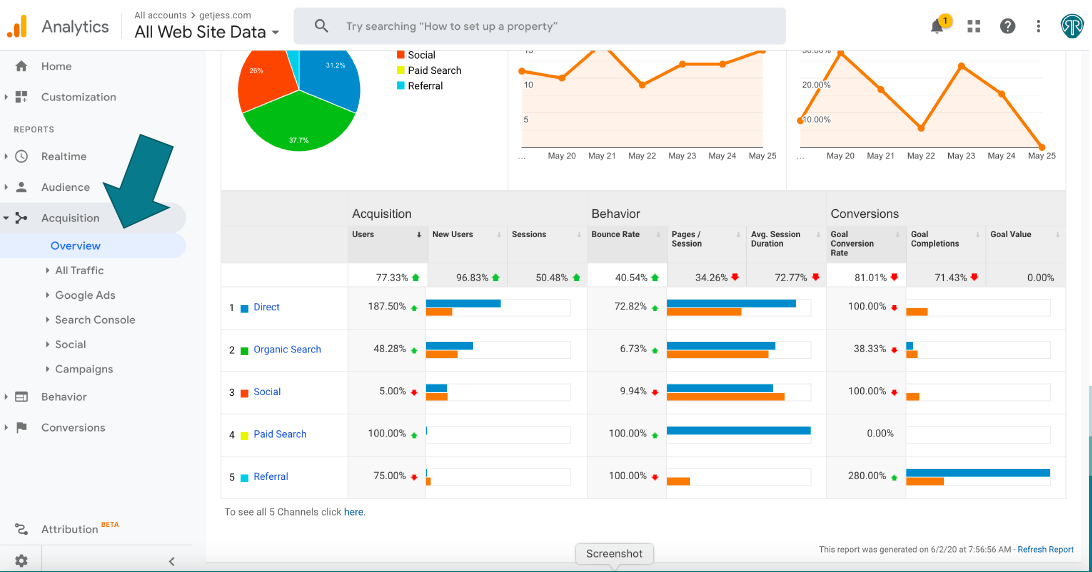When Does the Google Analytics Tracking Code Send an Event Hit to Analytics? Timing and Best Practices Explained
When Does the Google Analytics Tracking Code Send an Event Hit to Analytics? Timing and Best Practices Explained
Blog Article
Maximize Your Web Site Efficiency With Google Analytics Tracking Code
In the digital landscape, recognizing user communications with your site is crucial for optimization. By integrating the Google Analytics tracking code, you can unlock a riches of information relating to visitor habits, allowing you to keep track of essential metrics and recognize prospective locations for enhancement. This calculated implementation not just educates your choices but likewise paves the method for a much more appealing user experience. Nevertheless, the actual obstacle lies in successfully analyzing this data and converting insights into workable approaches. What steps can you take to guarantee you are fully leveraging these insights for ideal efficiency?
Recognizing Google Analytics
Recognizing Google Analytics is important for web site proprietors and online marketers aiming to enhance their on the internet visibility. This effective device gives critical insights into user behavior, allowing stakeholders to make data-driven decisions. By tracking various metrics, such as page sights, bounce rates, and user demographics, Google Analytics helps identify which aspects of a website are carrying out well and which need enhancement.
Among the crucial functions of Google Analytics is its capability to section information. Users can examine web traffic sources, user engagement, and conversion prices across various segments, such as geographic places or gadget types. This granularity makes it possible for online marketers to customize their methods to details target markets, thus enhancing the efficiency of their campaigns.

Establishing Up Tracking Code
To harness the full potential of Google Analytics, establishing up the tracking code properly is a fundamental action. The tracking code, a fragment of JavaScript, makes it possible for Google Analytics to accumulate data about customer communications on your web site.
Following, you'll require to install this code right into the HTML of your site. Ideally, place the tracking code simply before the closing tag on every page you want to check. Think about using plugins that assist in easy assimilation. if you're using a material monitoring system (CMS) like WordPress.
After carrying out the code, it's vital to validate its performance. Use the "Real-Time" reports in Google Analytics to verify that information is being collected as anticipated. By guaranteeing correct setup, you create a strong structure for effective data evaluation and calculated decision-making to enhance your site's performance.
Key Metrics to Monitor
Consistently keeping track of crucial metrics in Google Analytics is necessary for analyzing your internet site's efficiency and user interaction. Amongst the essential metrics to track are page views, which provide insight right into just how usually customers see various web pages on your website. Furthermore, distinct visitors help you understand the reach of your web content by showing the amount of distinct he has a good point users are involving with your website over a provided period.
Bounce price is one more vital metric, disclosing the percent of visitors that leave your website after seeing only one web page. A high bounce rate might indicate issues with material significance or user experience. Alternatively, session period indicates just how long visitors remain on your website, aiding you assess material performance and individual rate of interest.
Conversion rates are crucial for determining the success of your web site in attaining details goals, such as form submissions or product purchases (when does the google analytics tracking code send an event hit to analytics?). Keeping track of traffic sources is additionally key, as it aids recognize which channels drive the most traffic and hop over to here conversions, enabling even more targeted marketing approaches
Analyzing Site Visitor Behavior

In addition, tracking individual pathways via the website helps expose typical navigation patterns. This information is important in figuring out whether individuals can quickly discover the web content they look for or if they run into barriers that result in disappointment. Recognizing high exit web pages can highlight areas that might need redesign or even more engaging material to keep site visitors.
Furthermore, segmenting customers based upon demographics, rate of interests, and actions provides a deeper understanding of the target market. This division enables businesses to tailor content and advertising and marketing techniques much more properly, boosting the chance of conversions. Ultimately, evaluating site visitor behavior not only notifies internet site enhancements but likewise cultivates a more user-centric method, resulting her response in boosted complete satisfaction and commitment gradually.
Carrying Out Data-Driven Changes
Applying data-driven adjustments is important for enhancing internet site performance and accomplishing company objectives. By leveraging understandings gathered from Google Analytics, companies can identify areas for improvement and make educated choices to optimize user experience.
First, analyze crucial efficiency indicators (KPIs) such as bounce rates, session duration, and conversion prices to pinpoint particular problems influencing customer interaction - when does the google analytics tracking code send an event hit to analytics?. As an example, a high bounce rate on a touchdown page might indicate that the material is not resonating with site visitors or that the web page takes too long to lots

Conclusion
In final thought, the application of Google Analytics tracking code is vital for enhancing site performance. By accurately keeping track of customer actions and essential metrics, useful insights can be gained, facilitating data-driven decision-making.
By tracking numerous metrics, such as page views, bounce rates, and user demographics, Google Analytics assists identify which facets of a web site are carrying out well and which require renovation.
Users can assess traffic resources, individual involvement, and conversion rates throughout different sectors, such as geographic areas or tool types. The monitoring code, a bit of JavaScript, enables Google Analytics to accumulate data regarding individual communications on your website.On a regular basis monitoring key metrics in Google Analytics is essential for analyzing your site's efficiency and user involvement. By leveraging Google Analytics, web site proprietors can acquire beneficial understandings right into how individuals engage with their site.
Report this page